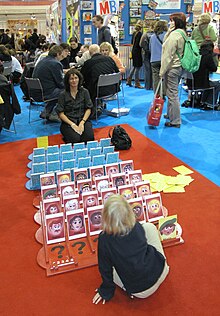Who is it?
| Who is it? | |
|---|---|
| Game data | |
| author | Theo and Ora Coster (Theora Design) |
| graphic | Theora design |
| publishing company | Milton Bradley Company (MB), Hasbro |
| Publishing year | since 1979 |
| Art | Deduction game |
| Teammates | 2 |
| Duration | about 20 minutes |
| Age | from age 6
|
| Awards | |
|
Årets Børnespil 1989 ("Best Children's Game 1989", Denmark) |
|

Who is it? is a deduction game for two players, ages 6+ . It was first published in 1979 by the Milton Bradley Company (MB) in Great Britain and from 1982 in the United States under the English title Guess Who? The game was released in Germany in 1988.
Gameplay
Each player receives a game board with 24 foldable tiles on which the faces of 24 different people are depicted. Each face has a unique combination of characteristics: hair color, hair length, eye color, beard growth, headgear, etc. The same faces are also printed on 24 cards which are shuffled before the game and from which each player draws a card face down - it shows it Person that the other person has to find.
In order to track down the identity of the person they are looking for, both players now alternately ask each other yes / no questions , such as “Does the person I am looking for have blonde hair?” Or “Does the person wear glasses?” . The opponent must answer each question truthfully. The aim of the question is to restrict the selection of candidates as much as possible. The faces of the eliminated people are closed.
If a player was able to narrow the selection down to exactly one person, he is always the person he is looking for. However, a player can try to guess the person he is looking for beforehand. This is useful, for example, if the selection was narrowed down to two people or if the opponent would win in the next round.
Development and versions
The game was conceived by Israeli toy inventors and game authors Theo and Ora Coster (Theora Design) for MB . The first edition appeared in Great Britain in 1979 under the title Guess Who? , followed shortly thereafter by a publication in some other European countries, including the Netherlands (Wie is het?) and France (Qui est-ce?) . It wasn't until 1988 that the game appeared in German under the title Wer ist es? . The game has now been released in over 28 countries.
Travel or compact editions were often published for the game, in which the selection of people was reduced from 24 to 20. Simpler versions of the game were included in the McDonald’s and Burger King children's menus . 2008 appeared with Who is it? Gallery (English: Guess Who? Extra ) an electronic version.
There were also several special editions of the game that show characters from Star Wars , Disney films , Marvel comics , Pokémon or the animated film Cars 2 , for example .
layout
The apparently arbitrary design of the faces was already based on certain rules in the first version, which were largely retained in all new editions: the faces are designed in such a way that five of the total of 24 people (or figures) have a certain characteristic and the other 19 Not. For example, five people have a big nose and the other 19 have a small nose. Originally the hair color with five variants was the only exception in the concept, but in the course of the modernization of the game, the proportion of female faces was also increased (albeit only marginally): While the first versions of the game still showed five women, it is in newer editions mostly eight women.
In general, the game material and especially the faces have been revised and modernized several times over the decades. The faces in the newer editions are much more colorful and varied, and the eyes are drawn increasingly larger . New versions also show other motifs, such as animals.
In the new editions from 2007, including the electronic version Who is it? Gallery , the faces or figures are printed on a separate sheet, which is inserted into the game board and can also be exchanged in order to offer the players variety.
Web links
- Who is it? in the Luding games database
- Who is it? in the games database BoardGameGeek (English)
- Commercial: MB presents Who is it? on YouTube
- Online playable version (English)
Individual evidence
- ↑ Guess Who? ( Memento of the original from December 7, 2013 in the Internet Archive ) Info: The archive link was inserted automatically and has not yet been checked. Please check the original and archive link according to the instructions and then remove this notice. on the developer's website